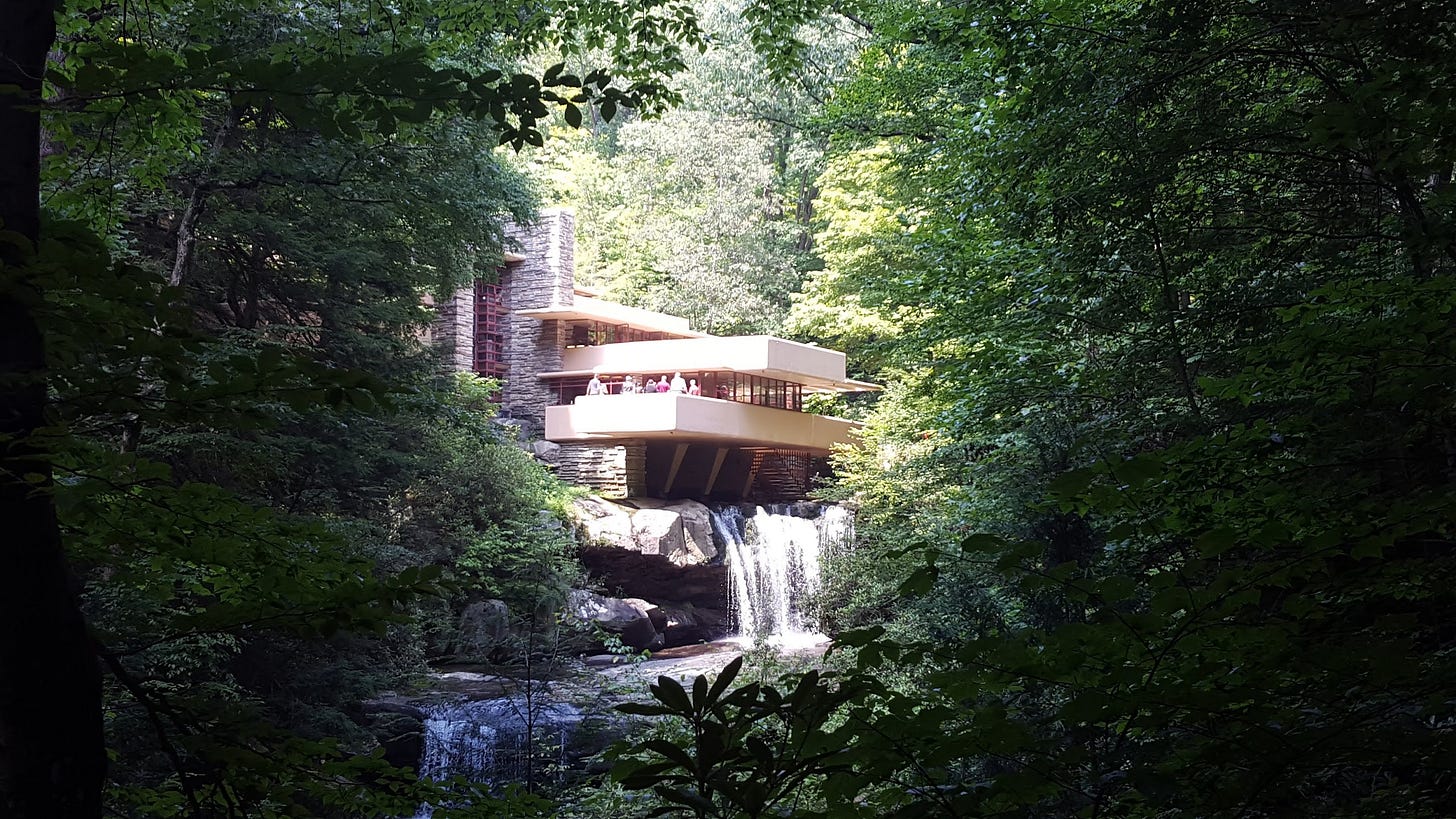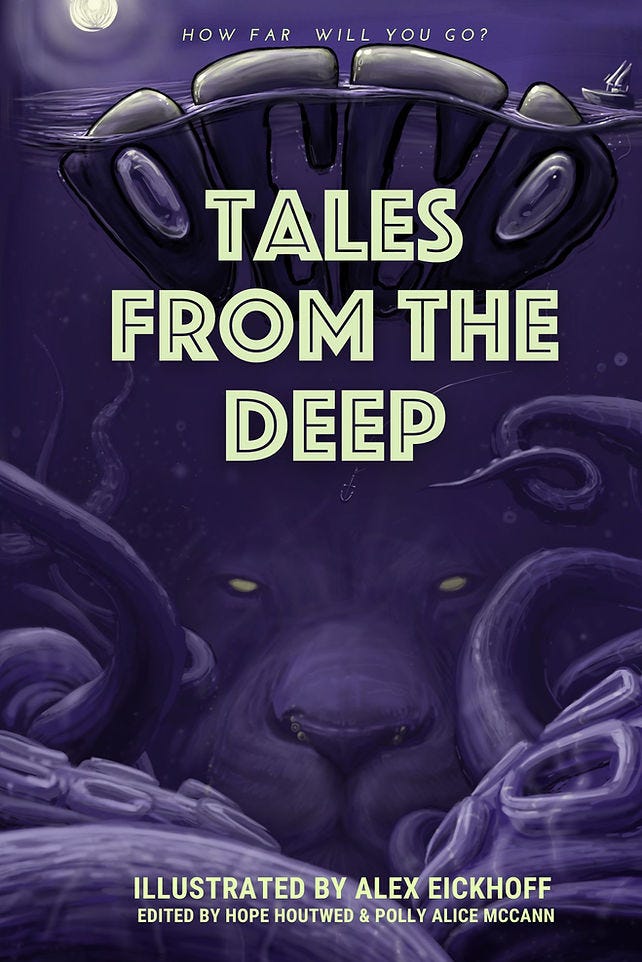On Fallingwater and "Tales from the Deep"
Fiction anthology feat. my short story, "Falling" is available now
The Architect drew a sheet of paper from his valise, drew a smile at the corner of his lips.
“Now sir,” Edward Sr. said, “are you the sort of architect who believes that a house is a machine for living? That is the fashion now. I’ve entertained your visit because I have a friend, in Chicago, who still raves about the house you built for him and his wife—twenty years ago. Tell me, can you build me a country house for the machine age? My wife desires something more modest, but as a fashionable business, we have some duty to keep up with the trends.”
“My architecture is not for fashions of the moment, Mr. Zeliger,” The Architect declared. “It is to stand for all time. This new architecture, these barren slabs and steel beams, they are not designed with man and his humanity in mind.” As The Architect spoke, his hand, now stable, glided across the paper, his pen darting as he sketched. “I design for harmony with nature. A house should express man’s deepest desires, but it should never lose sight of its context.”
Edward Sr. nodded. “That’s all very nice, but how could you achieve such an effect?”
“Quite simply—I shake the buildings out of my sleeves.” The Architect capped his fountain pen. He handed his client the sketch.
After a moment, Edward Sr. said, “You must be some sort of god.”
“Something like that.”
—from the short story “Falling,” featured in Tales from the Deep.
In 2018, I drove across the country with my father to start my graduate program in Nevada. On our trip we stopped in the placid woods of Bear Run, Pennsylvania, to make a particular architectural pilgrimage—to visit Fallingwater, a modern house built dramatically on the edge of a waterfall.
Once the summer home of the Kaufmann department store family, which had a flagship store in nearby Pittsburgh, Fallingwater (built in 1936-1939) is often celebrated as the greatest achievement of the quintessential (and quite prickly) American architect, Frank Lloyd Wright.
By all accounts, Frank Lloyd Wright was a very difficult personality. An exacting egomaniac who often imposed his will on his clients, Wright survived long periods of destitution (and even a horrific, bizarre murder case) to a long career across North America (and Japan). Combining modern architecture with Japanese aesthetics to form his iconic “prairie” and “Usonian” building styles, Wright’s architecture was far ahead of its time, his vision suggesting forms of architecture that wouldn’t achieve widespread adoption until after World War II—the open plan office and the midcentury ranch style house among his innovations.
When we visited Fallingwater, our docent took us through the house’s expansive living room, built into the side of a natural rock, with a patio below where the sound of the water could emanate into the room. Our guide explained that the house was supposed to cost $35,000, but it went over budget to $155,000 (a cost of $17.6 million today). The house’s construction did not alleviate the patron family’s personal troubles; in 1954 E.J. Kaufmann’s first wife Liliane died of an overdose of Seconal, a barbiturate.

Fallingwater’s critical acclaim had the side effect of elevating Wright’s career, which had been dormant during the Great Depression, and paved the way for a new wave of contracts which enabled him to reach his now-rarified status, culminating in his 1959 design for the Guggenheim Museum in Manhattan. The experience of the Fallingwater house influenced E.J. Kaufmann’s son, E.J. Kaufmann Jr., into becoming an important architectural historian and champion of Wright’s oeuvre (it was E.J. Kaufmann Jr.’s interest in Wright which had led his father into hiring the irascible Wright in the first place).
The story of an affluent family under the severe financial stress of bearing Wright’s vision (and resurrecting Wright’s career) formed the germ of an idea for a short story. What if Wright was more than just a visionary, but some sort of supernatural force? And how could one reimagine the relationship between Kaufmann Jr. and Wright as this elemental struggle between art and the pain required to uphold and fashion such aesthetic beauty?
My short story, “Falling,” reimagines the construction of Fallingwater as a gothic horror story, where Fallingwater is like a haunted house as imagined by an architect-deity at the behest of an affluent-yet-troubled department store family. Written during my time in the MFA program at the University of Nevada-Reno, I am thrilled that it has found a home in Flying Ketchup Press’ short fiction anthology Tales from the Deep, available now in paperback and ebook.
Featuring speculative fiction tales from a variety of talented up-and-coming writers, the long-awaited Tales from the Deep has been in the publication pipeline for three year. The book is also illustrated with beautiful art by Kansas City-based artist Alex Eickhoff. The book costs $17.99 in paperback and $5.99 on Kindle; you can order it from Amazon at this link.
This coming Saturday, October 22, 2022, there will be a virtual launch event at 2 PM ET / 11 AM PT, which you can register to attend for free by clicking on the Eventbrite link. During that event, I will read from an excerpt of the story. You can also read more about “Falling” in an interview I did in 2021 on the Flying Ketchup Press website.
For more on Wright and the real-life story of the construction of Fallingwater, I recommend Franklin Toker’s 2005 book Fallingwater Rising, as well as Paul Hendrickson’s endlessly fascinating (but stylistically overbearing) experimental biography of the man, Plagued by Fire.
Thank you once again for your support and your readership of this newsletter—it’s so nice to see some of my creative work, written years before, finally make it into the world.




